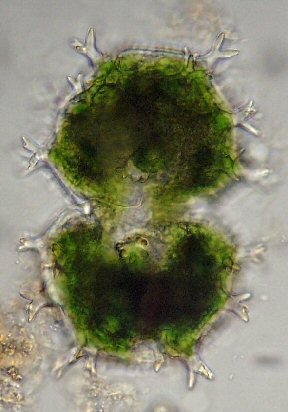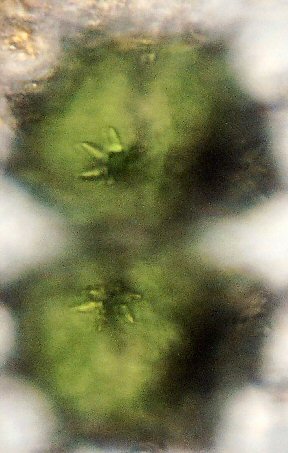

|
by Bill Ells, UK |
'This variety is one of the very handsomest of British Desmids' wrote W. & G.S. West (1) describing Xanthidium armatum var. cervicorne W.& G.S.West 1898. Cervicorne is one of four varieties of the species in the British Checklist (2). It can be distinguished from the other varieties by its longer 3-5 furcate more ornate spines, Fig. 1, and the larger teeth in the central protrusions of each semi-cell, Fig 2. The specimen in the photo's is 133 µm long, 93.5 µm broad, from a water sample collected from Druimdarroch, Scotland by Alastair Bruce.


Figures 1 and 2.
Xanthidium armatum var. armatum (Bréb) Rabenhorst 1847 has short spines and a circle of small teeth around the central protrusions of each semi-cell.
Xanthidium armatum var. irregularis W.West 1892 has very short spines described by the West as emarginate or tridentate warts and a circle of small teeth as for var. armatum.
Xanthidium armatum var. fissum Nordstedt 1878 is very rare, it has longer spines than var. armatum with teeth in the central protrusions of each semi-cell as in Fig 2. but fewer and much smaller.
Even the beginner in the study of freshwater micro-organisms should not confuse the species armatum of the genus Xanthidium with any other desmid, careful examination is needed to determine the variety.
Acknowledgement:- Many thanks to Alastair Bruce for providing me with samples of fresh water from Scottish lochs and streams.
References:-
(1) W. & G.S. West A monograph of the British Desmidiaceć 1912 Vol. 4. Pages 54/55 & plate 106. Pub. The Ray Society London.
(2) A.J. Brook - D.B. Williamson A Check-List of Desmids of the British Isles 1991. Occasional publication No.28 The Freshwater Biological Association.
Note:- The first volume of a new monograph on British Desmids by Brook & Williamson is soon to be published by The Ray Society (c/o The Natural History Museum, London).
Readers interested in taking photomicrographs may like to know that I recently bought an inexpensive Premier digital camera which claims 4 megapixels resolution (I have not counted them) and has 3 times optical + digital zoom. I took the 2 pictures shown here by holding the camera lens just above one of my Nikon x10 high eye point lens. I have not yet got around to making any form of adapter although I need to do so as I had difficulty in keeping the camera still.
William (Bill) Ells.
All comments to the author Bill Ells are welcomed.